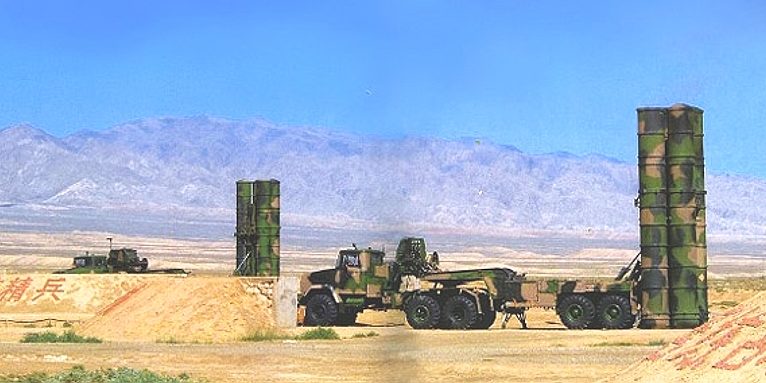Quick Facts
| PRC/NATO Designation | HQ-15 (SA-10D Grumble / SA-20A Gargoyle) |
| Variants |
HQ-10 (SA-20A Gargoyle A / S-300PMU-1) HQ-15 (SA-20B Gargoyle B / S-300PMU-2) |
| Mobility and Role | Ground-based/road-mobile; short-range air and missile defense |
| Interceptor and Range | 5V55K missile (45 km), 5V55R missile (75 km), 48N6 missile (150 km), 48N6E2 missile (200 km) |
| Sensors |
Clam Shell continuous wave pulse Doppler acquisition radar Flap Lid phased-array engagement radar Big Bird F-Band long-range surveillance and tracking radar |
| Targets | Cruise missiles, low-flying aircraft, short- to medium-range ballistic missiles |
| Status/Exports | Operational; Exported to Greece, Slovakia, and Vietnam |
| Designer/Producer | Almaz-Antey Concern/PLA |
Overview
The Hong Qi-15 (HQ-15, previously referred to as the HQ-10) is a Chinese reverse-engineered copy of the Russian S-300PMU-1 aerial defense system. The first “deep modernization” of the S-300 series yielded the S-300PMU-1, which is designed to destroy anti-ballistic missiles.[i]The HQ-15 boasts extended radar footprints, more efficient automation, and advanced defensive capability against ballistic missiles “with re-entry speeds of up to 2.8 km/sec,” which make it comparable to the American PAC-2 system.[ii]The ABM ability is made possible due to 64N6E Big Bird radar, which has an aperture 30 percent wider than the U.S. TP/SPY-1 Radar.[iii]Further development of the HQ-10 precipitated the HQ-15, which is much more commonly used and is comparable to the S-300PMU-2. A typical HQ-15 battery includes Clam Shell continuous wave pulse Doppler acquisition radar, Flap Lid phased-array engagement radar, Big Bird F-band long-range surveillance and tracking radar, and up to 12 launch vehicles with capacity for four missiles each, along with command-and-control and generator units.[iv]Since the PLA initially imported several dozen S-300PMU-1 units in 1993, the system has been reverse-engineered and reproduced (the HQ-10) and upgraded with extended engagement range (HQ-15).[v]
Strategic Implications
The HQ-15 offers reliable protection for Chinese military assets around Beijing and Shanghai, and nearly guarantees China the ability to destroy Tomahawk cruise missiles in the event of a conflict. China continues to deploy HQ-15 batteries along its eastern coastal zone, which produces up to 60 percent of Chinese gross domestic product, as well as near the Taiwan Strait.[vi]The range the 64N6E Big Bird radar affords would prove challenging for U.S. and allied forces to deal with, plus HQ-15 can dispatch most Taiwanese Mirage-2000 fighters. Only the Lockheed Martin F-22 Raptor, F-35 Lightning, and Northrop Grumman B-2 Spirit stealth bomber can operate in airspace protected by the HQ-15. Moreover, China is attempting to upgrade the HQ-15 to achieve capability comparable to the S-400 system.[vii]Such a feat would jeopardize some American stealth aircraft and counter the threat of deterrence posed by most cruise missiles.[viii]
Timeline
2007/2008:China deploys 4 additional battalions of the HQ-15.[ix]
October 1999: The PLA unveils its upgraded S-300PMU-1 systems, redesignated the HQ-15, in a military parade, stationing several around the eastern coastal zone.[x]
1995:Russia gives the PLA permission to license its S-300PMU-1 system for export and modification.
1993:The PLA receives at least two dozen S-300PMU-1 units from Russia and reverse-engineers a copy, the HQ-10.[xi]
1993:Almaz begins production of the S-300PMU-1, a downgraded version intended for export sales.[xii]
1985:The Russian military receives the S-300PMU (SA-20A Gargoyle) “second generation” system, featuring 5N64S Big Bird advanced radar capable of tracking 200 targets and engaging 24.
1982:Almaz develops theimproved S-300PS system, featuring a setup time of five minutes compared to the S-300PT’s thirty minutes.
1978:The S-300PT system enters service in the Soviet army.
1969:Almaz begins conceptual development of the S-300 BMD system.[xiii]
Recent News
References
[i]http://www.military-today.com/missiles/s300_pmu.htm
[ii]http://www.ausairpower.net/APA-Grumble-Gargoyle.html#mozTocId490214
[iii]https://3dwarehouse.sketchup.com/model/b63da01713d2d9e61bfeb646a8eadb57/64N6E-Big-Bird-D-Early-Warning-and-Battle-Management-Radar
[iv]https://fas.org/nuke/guide/russia/airdef/s-300pmu.htm
[v]http://archive.is/20070613205220/www.missilethreat.com/missiledefensesystems/id.29/system_detail.asp
[vi]Ibid.
[vii]http://www.newsmax.com/Pre-2008/Summarizing-the-Great-Threat/2002/07/15/id/667472/
[viii]http://xn—-7sbb5ahj4aiadq2m.xn--p1ai/guide/army/pv/s300p.shtml
[ix]http://www.ausairpower.net/APA-PLA-IADS-SAMs.html
[x]https://fas.org/programs/ssp/nukes/nuclearweapons/russia_nukescurrent/sa10.html
[xi]http://www.ausairpower.net/APA-Grumble-Gargoyle.html#mozTocId490214
[xii]Ibid.
[xiii]http://aviationweek.com/site-files/aviationweek.com/files/uploads/2015/07/asd_08_06_2015_dossier.pdf

